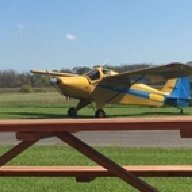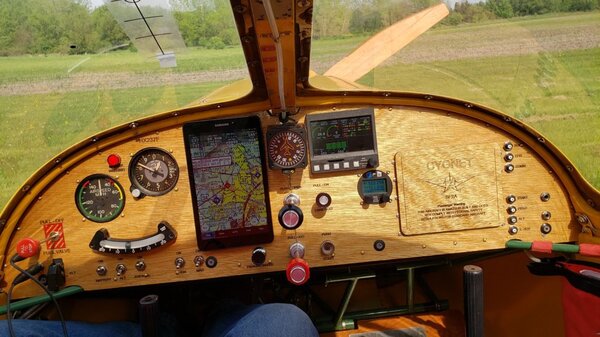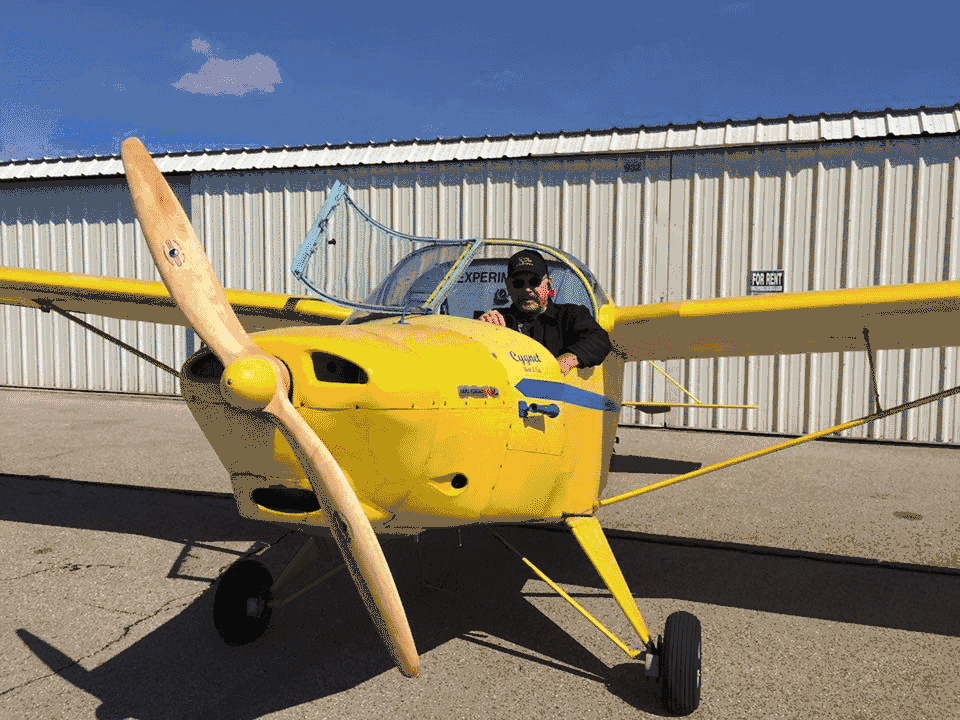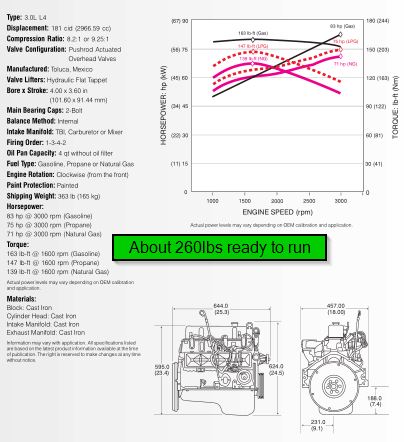-
Posts
27 -
Joined
-
Last visited
Content Type
Profiles
Forums
Gallery
Downloads
Blogs
Events
Store
Aircraft
Resources
Tutorials
Articles
Classifieds
Movies
Books
Community Map
Quizzes
Videos Directory
Posts posted by N237F
-
-
I have blended Steam and quasi glass into a clean configuration that works for my daytime VFR Cygnet SF2A.
A few details seen here essentially laser cut and engraved from Mahogany ply in two pieces becasue of the laser bed limit. Reinforced down the middle (throttle) and along the bottom for switches. Blends vintage steam modern EIS/Digital radios and a Samsung Tablet for AVARE. Works well all the controls are logically grouped to minimize potential create issues. One of those AV-30 Artificial Horizons may find it's way in 2021 in the off chance I wonder into a cloud.

-
 9
9
-
-
Zenith Carby on VW
I am fitting a new 1600 VW to my Jodel D9, with the original Zenith carby and intake system from my old Stamo engine. It worked well on the old donk; very economical and no hassles. It's fairly low profile, so visibility shouldn't be impaired too much.
Lyle
Pix attached
[ATTACH alt=no tunes.jpg]3199[/ATTACH]
[ATTACH alt=Side.jpg]3200[/ATTACH]
[ATTACH alt=top.jpg]3201[/ATTACH]
Lyle
I believe the dual port casting in a auto bring the induction forward to the pulley end. I suppose right and left castings are simply swapped to push the system to the flywheel end as shown. Any particular modification needed? DO you recall the casting weight?
Regards
Matt
-
Yep....fantastic visibility. It's the third plane I've built and when I was deciding it was going to be the Jodel sovereign or the Cygnet. The low wing on the Jodel and my experience with a low wing Minimax swung me to the Cygnet. A few people are put off by the Cygent's geodesic wooden wing structure but it was really easy to build....definitely easier than the Minimax, Karatoo or the Carbon Dragon wings I've built. The plane still puts a smile on my face after 17 years of operation. The Jab engine had put 15-20kts increased cruise speed and 400fpm extra climb rate compared to the old 1835VW engine.
Cygnets are Smile makers. They gather questions at every fuel pump from young and old.
I think of NX237F as a room with a view in the sky. https://www.youtube.com/results?search_query=NX237F
-
The new panel in action
-
I just rearranged my panel REF Cygnet SF2AI have had the MGL Xtreme for quite a while now but never used the EMS side of it just the AHRS. I have now fitted another Xtreme and use it as the EMS as well of course as a total backup instrument. I am very happy with the operation of it all . It was quite easy to setup the RDAC to all of the sensors and I made my own water temp sensors for the rotax as the MGL ones are the wrong threads for a Rotax.[ATTACH alt=IMG_2353.JPG]24156[/ATTACH]
I do set the back up altimiter prior to run up and use primarily as a EMS. I have fitter a big red Alarm pilot light that get your attentention is something approches limits set. My plane is daytime VFR only but I would like to add a horizion reference should I inadvertantly wander into a cloud I could confidently turn 180 and exit. Do you know if one extreme can do both functions I buy the ahrs sensor pack? Full time EMS and back up horizon is all I am after. Otherwise the big slip indicator gets smaller and I have a space reserved for a turn and bank or dedicated AH gyro.

-
Mark, How do you like the AHRS unit on the MGL?Visibility is fantastic. Compared to a Tecnam Bravo, Jabiru or a low wing, Cessnas etc its just tickety boo. On the ground and in the air the visibility is good.....the nose and dash are low, so superb fwd and down. Side windows allow visibility above and under the wings. Bubble glasshouse means up and to the rear up is good. Only blind spots are directly down and down towards the rear. I've never found the shoulder wing an issue. Checking out landing areas doesn't require a roll like is needed in many low wing aeroplanes, and its not difficult to check for aircraft on finals when taking off (unlike many high wing aeroplanes).Handling is very docile; roll is not fast, and the long fuselage means its not twitchy on elevator. Friese ailerons means you don't need big input on the rudder. No flaps, but she sideslips super well for glidepath control. Also it has pIsitive stability. ..you can fly hands off and while a thermal may give you a bump, it settles back down.
Matt, I find your fuel burn at cruise difficult to accept. Do you just divide your added fuel by your Hobbs hours, and therefore include climb, warm-up and descent? My numbers are from a calibrated fuel flow meter, and with the 1835 VW and with two people on board I was getting 16.5 lph @ 75-80kts and rpm say 3100 and this was with egts around 650C, so it wasn't running rich.
Here's a pic of my planes.
[ATTACH alt=20170627_114955.jpg]34765[/ATTACH]
[ATTACH alt=20180317_152309(1).jpg]34764[/ATTACH]
[ATTACH alt=20170419_103842.jpg]34766[/ATTACH]
-
LOL it came with the plane. Currently stuck on with double sided tape if I add a turn and bank or horizon to get out of unexpected clouds I will need to find a smaller one.Now THAT"S a slip indicator.. NevJust flew today and realize even with a good looking panel my eyes are outside 95% of the time. The big red pilot light in my view will get my attention if engine limits are approaching.
Matt
-
Ok the new panel flew! No magic smoke from all the new wires when tested on the ground or in the air. I like the end result!
Fritz posted on a US page about it too.
[/url]https://www.homebuiltairplanes.com/forums/threads/clever-cygnet-panel.31673/
-
 2
2
-
-
LyleZenith Carby on VWI am fitting a new 1600 VW to my Jodel D9, with the original Zenith carby and intake system from my old Stamo engine. It worked well on the old donk; very economical and no hassles. It's fairly low profile, so visibility shouldn't be impaired too much.
Lyle
Pix attached
[ATTACH]3089[/ATTACH]
[ATTACH]3090[/ATTACH]
[ATTACH]3091[/ATTACH]
Any reason I could not locate my carb behind my oil to air cooler in the Cygnet to achieve what you have?
My fuel distribution issue surfaces again with with the revflo slung under the engine.
I woudl probably switch to a float carb that can take fuel pump pressure.
Matt
-
-
Great looking Bird Doran, Hope to see you at our flyin in September. Anyone with interest in the Cygnet SF2A design is welcome to come.Cpl of pics of N6580K.[ATTACH]54345[/ATTACH][ATTACH]54346[/ATTACH]
[ATTACH]54347[/ATTACH]
[ATTACH]54348[/ATTACH]
2018 Cygnet Type Aircraft Gathering Save The Date
Matt
-
SMatt,
I am in the same boat. I was told you could build a airplane in Kindergarten. Flew as a teen as money allowed 15 hours in a cub at $12/hour wet last entry was in 1987. The Spring I bought the Cygnet flying is restricted more by life and weather than money now...But I too am at the cusp of solo. A good instructor will not cut you loose until you are well prepared. I need only to shoot a few crosswind landings with mine and I will solo!
Enjoy the process.
Matt
-
 2
2
-
-
I see this is a 2007 entry what is your progress report?
I am currently going for a US LSP ticket in a historic Lindy Award winning Cygnet Built in Canada by Zig Berzins. Superb craftsmanship, routine engine operations excellent control harmony and rugged landing gear make this a excellent fun flyer to learn in.
2276VW with dual ignition,electric start and a revflo carb work well but about 40lbs heavier than I like. The Jab2200 or a 912 rotax would also be excellent choices if building new.
REF
Matt
-
Mark,
I have yet to verify as I am not yet doing cross country where careful fuel consumption can be monitored the data I have is from a previous owner who fitted the 2276.
"105 mph on 50 percent power (19.5” MP)"
However I took the stated fuel burn and converted to Liters per hour from US gallons. My plane started life in Canada so on review the hash marks are actually imperial gallons which converts to ~16lph in good alignment with yours.
I am encourages by your panel layout. I want to add a steam gauge altimeter to mine and lay it out again with the fuel down the center of the panel. My future appears to be similar your current layout.
Early in the training more focused on landings and slow flight so fuel consumption will be minimal. We have however established minim sink speeds and best glide speeds. The plane is well suited for newer pilots. I am currently working to unlearn my J3 cub rudder habits from 1987.
I like to fly in full trim the control harmony is remarkable as is the view. Once trimmed it flies hands off if desired. I bought it for the view but the economical consumption factors and the mild flight characteristics are quite a bonus. I am surprised there are only ~120ish around the world.
Regards
Matt
-
The mid wing does crate a rather large blind spot from where you have been. One does need to tip a wing to clear an area if any large turns are to be executed with confidence. The trade off is acceptable for the remarkable view. A period of calibration to map your memory to visual reference no including your wings is required. Once done perfectly coordinated turns are super easy only looking out the window.
Every designer makes trade offs. I like the ones made by Bert Sisler and it does have a hind quarter blind spot with a great view where you are going.
http://vikingaircraft.com/designer/
-
Mark
Wow such a light build is commendable. If I build one I will target what you achieved. Mine is heavier than I like but climbs at full gross and 500-600fpm with a 2276CCvw. Full dual ignition and electric start make it comfortable but heavy. Ed Sterba 58x34 prop The Jab is easy 20-25kg lighter. I have a impulse mag and Compufire electronic ignition with mechanical advance so hand propping may allow me to loose 8kg. My cruise is about 90knts at 13lph. We will be organizing a type fly in at my home airport 02C Wisconsin in September 2018. A bit far to fly but if you are passing trough we will save you a brat. We will have Viking Aircraft and hopefully 5 other cygnets in the Gaggle. Date TBD.
For those on the list unfamiliar with the Cygnet I attached a illustration of the egress method... ingress is simply the reverse. Pat Taylor demonstrating in the Sisler prototype.
The view forward is tremendous unlike any tail wheel I have flown. No need for S turns on the ground.
Regards
Matt enjoying NX237F working on a Light Sport Pilot ticket with it when the weather permits.
-
I just flew NX237F for the first time yesterday for 1 hour after owning it for about 35 days waiting for the weather to clear.
Very good stability with excellent visibility. There are about 100+ of these around the world with about 20 in the US and 13-18 in Australia the remainder are in Europe where the efficiency is appreciated due to the large fuel taxes.
I encourage you to consider building one for yourself.
Why Build the Cygnet | Viking Aircraft
REF
And Tony's Videos showing off the excellent visibility even while on the ground.
http://www.youtube.com/watch?v=ilK3Uj4Dxfk
And then you have this adventure!
Yes if you like Rag and Tube Constructions consider building another Cygnet the world will be a batter place for it!
If you own a Cygnet please reach out to me and tell me about it. We will try to organize a flock of Cygnets for the 50th anniversary of the design.
Matt
-
I see so Old Koreelah is an earned title of distinction for someone with knowledge of the ancients yet willing to adapt to new technology as it is proven out. You would be well received on the inner circle of the EAA headquarters should you ever choose to escape Australia. Let me know if you plan to attend Oshkosh in the future so we can fly a sorti together and I can continue to learn from you!
Matt
-
-
Ah a new unit of measure to calibrate on 21kg-3.31 stones "Mobs plural" either 2-3 assume 3 so a mob is approximately 1.102 stones. You have to love an approximation to 3 places. All joking aside... Yes Bob was a gem and a great loss. His words were carefully chosen not to lead anyone astray. He always impressed on his followers that "You are the Mechanic In Charge" Serious business when it comes to committing aviation.
The blog is a treasure to anyone building or feeding a VW and practical on many other avenues for Life and Aviation in general.
Best
Matt
-
The JAB2200 looks like a good fit for the Cygnet. The original Sisler Prototype was fitted with one before it returned to the Taylor family Pat and Robin at Viking Aircraft World Headquarters in Burlington WI.Guys, I've been following this thread as I've just installed a Jab2200 rollercam in my Cygnet which previously had an 1835VW, and I've had the usual issues sorting out cooling. I've now got about 23 hours with the Jab motor.My CHT temps at cruise with 25C OAT and at 90kts are 140, 122, 135, 120 & EGTs at around 15.5lph are 695, 650, 690, 645 at between 4000asl and 5000asl. Rpm 2900. They max if I throttle back to 14lph and 80kt and 2750rpm at 720, 660, 720, 645. No matter what I do I can't get the stb cylinders cooler. No 1 & 2 were my hottest cht wise, but baffles in the pressure ducts were adjusted to get rear cylinders chts as close as possible to the front.I originally had over 120C egt spread and that was mostly fixed by putting a fence of about 2cm high in front of the air inlet (which is simply a hole in the side of the cowl). This makes sure there is no ram air. Drawing cowl air made no difference. I also have flow straighteners in the airbox outlet and carb inlet. I do not have a simple cross because, if placed in the nsew orientation, the bottom interferes with the emulsion tube air inlet on the Bing and minute changes produce crazy results. When I installed the fence on my air intake my egt spread dropped and the average egts dropped so I've gone one size smaller on main and needle jets (230 & 2.8 if my memory is ok).
I was getting over 140C CHT on no.1 in cruise and oil temps over 90C so I ditched the 50mm lip on the cowl outlet and replaced it with a ramp for more suction. Result was a 5-10C drop on all CHTs and oil temps now mid 70s...so my next step is to put in a plate to exhaust the oil cooler air separately from the cylinders and adjust for mid 80C OT.....I'm worried about winter. Downside is higher Chts on 3&4 when taxiing (+135C).
My problem is on climb. When I go WOT, no.4 goes lean and the egt will, if allowed, runaway over 720C. So I throttle back to 3050 rpm where my egts are 650, 670, 645, 690 (Fuel flow somewhere around 25lph). CHTs on climb at 70-75kts don't go above 150C so far. If I rotate the carb to even mixture on cruise, it makes it much worse on WOT. And yes, the butterfly throttle is limited to 80 degrees open. By throttling back I lose about 50 to 100 revs on climb.
So now I'm reasonably happy and thinking there is just some tweaking on the cowl outlet with perhaps a bit of exhaust augmentation. I'm thinking my right bank is running hotter because that side is leaner and that may be because the inlet plenum diffuser is not exactly centre, or because of the orientation of the 4 horizontal holes in the emulsion tube/ atomizer which the needle jet sits in, or how the needle lays in the needle jet, eg it might lie against the stb side causing the fuel spray/plume to favour the port side?
I get a small drop of oil at the front crankshaft oil seal. Is this normal? Motor runs very smooth.
Cygnet Sport Airplane Light Engine Choices | Viking Aircraft
They paid a visit when Zig Berzins Award Winning Cygnet now sporting a US N-number arrived in Wisconsin flown by it's 4th owner & Cygnet Builder Jerry Folkerts. (See two in the barn) Mine ignores the direction to limit your VW to 1835 sitting at 2276cc. The build is super clean external fasteners were streamlined. Performance: 105 mph on 50 percent power (19.5” MP) I am told on 3 us gallons per hour TBC.
All Cygnets possess great Visibility ground and Air = No S-turns except to avoid potholes or trash on the ground you can see 5 feet in front of the prop!
http://www.youtube.com/watch?v=ilK3Uj4Dxfk
For the record! Ok obvious now I like the design.
We only have about 20 in the US and 100+ world wide I am under the impression the Australia has quite a stash of Cygnets. I think the UK is close behind for second place.
The Deisign is 45 years old this year.. Give me the privelage of a tail number NX237F in lieu of the big word EXPERIMENTAL embossed in large friendly letters on the side. I would like to organize a gaggle of cygnet before after or during Oshkosh. The Austrailian airline used to haul a boat load of people to oshkosh if you fellow would pull the wings we could make it a real big bash. Target 40!
Best
Matt
-
You can't go wrong with the Ed Fisher Designed Flit Plane. An ultralight with aircraft materials and construction classic rag and tube. Ed is one of the best at the minimalist end of the designs. Tubes all selected for load paths results in light strong good flying airplanes. Roger makes accessible designs as well most are all wood a truly great medium. Finding you can only make large fortunes smaller in aviation he has a day job but still manages decent technical support. The Lighter side Part 103 on this side of the pond is a siren. Milholands Legal Eagle Xl is close to the top of my list. We are fortunate Zing and Cloudster designs have been salvaged from the past. Simplex Aeroplanes – Home of the Cloudster and Zing Aircraft DesignsI had almost decided to go with Wings of Freedom's Flit Plane. I like it a lot. They have a kit, and plans available. Then the RW9 resurfaced,and sold me. Do check out Roger Mann's website, Ragwing aircraft. He no longer offers kits, but has plans for about seven airplanes I think. He also has plans for boats. Maybe build yerself a boat plane!Now I have officially commented more than I have in 20 years on aviation. It is good to be in the game again! This is a great forum.
Best
Matt
-
Agreed! Cold weather operations will make the long intake manifold issue more pronounced. Some added heat is required at lower settings!
I see several Cygnets reside in Australia any near you? Have them give me a shout.
Matt
-
I concur. Parasols are less expensive to build! I have flown and enjoyed PIetenpols aith direct drive high compression FORD A with babbits replaced by shell bearings engine with very peppy performance provided by a very long prop. (Took off faster and climbed better than a 0200 Pietenpol) A simpler form would be to take a big heavy industrial engine to do the same see Bob's article below! While the Piet is a tumbleweed draggy airplane it possess good style with the glide path of a brick but low overall hp requirements so reliability can be had by not asking too much from a big automotive plant. More fun for the dollar than any other. Probably 200 in the US flying on A, 20+ on other industrial chuggers producing about 60hp below 2400 rpm direct drive. Another 650-800 flying on continental 65hp speaks well for our surplus market.. To avoid the re drive you need allot of wing to fly on 65hp or less tolerance for engine weight target 3l+. The Piet with it's easy to position wing is a good choice for rugged cheap flight!If you want cheap, cheerful and reliable then do a Heath parasol or similar design and add a total two stroke. Shop around and $2,500 for a good rotax with redrive will provide plenty of thrust in which to trust. It's all about condition and managing your two stroke.The Texas parasol group is great and is very cheap to build, lots flying and not a huge amount of build hours. as it is built from angle alloy it is cheap. A tube frame in alloy of aircraft grade costs considerably more. The covering is up to you but can be cheap or very expensive eg. Oratex.The more you can do and make yourself the cheaper, go second hand when possible and enjoy. A used rotax or Kawasaki or Hirth two stroke will be fine and more reliable than a home cobbled motor/ box combo.
Resist the temptation of a untried motor and untried air frame, too much to go wrong and you only have one life.
Bob Hoover's Blog: Flying on the Cheap
Unfortunate GM retired the engine mentioned recently prior to this you could score a new long block with carb and ignition for $1,800USD.
Best
Matt









In Cockpit Noise - How to reduce?
in AUS/NZ General Discussion
Posted
I posted on another list about a concept I call Compound ANR. Quality ANC hearing protection for $40 or or Compound ANC for $400
It really tames the snarl of upen VW pipes!